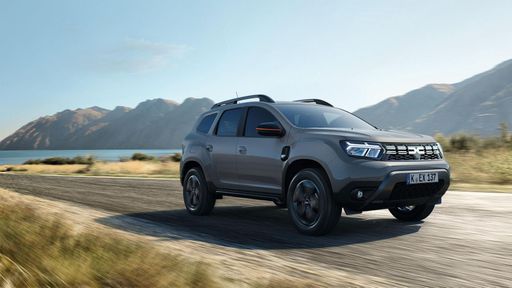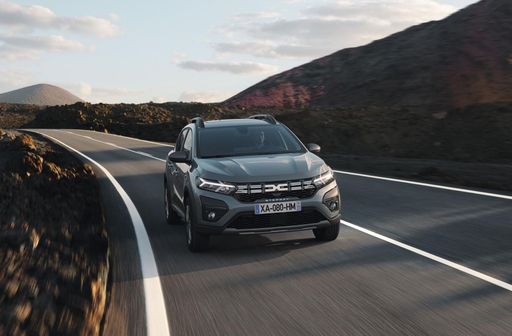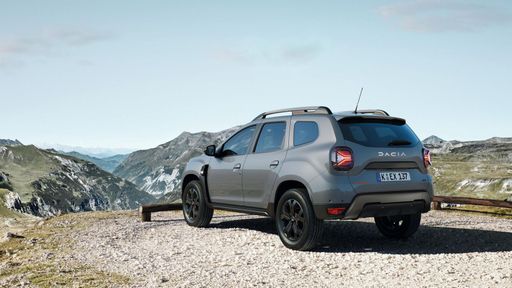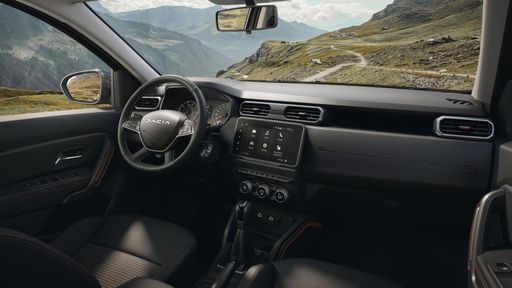Renault Trafic Transporter vs Dacia Duster – Differences & prices compared
Compare performance, boot space, consumption and price in one view.
Find out now: which car is the better choice for you – Renault Trafic Transporter or Dacia Duster?
The Renault Trafic Transporter (Cargo Van) comes with a Diesel or Electric engine and Manuel or Automatic transmission. In comparison, the Dacia Duster (SUV) features a LPG, Full Hybrid or Petrol MHEV engine with Manuel or Automatic transmission.
When it comes to boot capacity, the Renault Trafic Transporter offers , while the Dacia Duster provides 517 L – depending on how much space you need. If you’re looking for more power, decide whether the 170 HP of the Renault Trafic Transporter or the 140 HP of the Dacia Duster suits your needs better.
In terms of consumption, the values are 21.30 kWh6.70 L per 100 km for the Renault Trafic Transporter, and 5 L for the Dacia Duster.
Price-wise, the Renault Trafic Transporter starts at 33200 £, while the Dacia Duster is available from 16300 £. Compare all the details and find out which model fits your lifestyle best!
Renault Trafic Transporter
The Renault Trafic Transporter is a versatile vehicle known for its spacious interior and functional design, ideal for both business and personal use. Its stylish exterior combined with practical features offers a perfect balance between form and function, making it a popular choice among van enthusiasts. The driving experience is enhanced by its smooth handling and advanced technology, providing comfort and convenience for any journey.
detailsDacia Duster
The Dacia Duster represents a compelling choice for those seeking an affordable yet robust SUV in the market. With its rugged design and practicality, it tackles both urban commutes and off-road adventures with ease. Inside, the vehicle offers a spacious cabin that ensures comfort, while maintaining its reputation for delivering excellent value for money.
details @ dacia-presse.de
@ dacia-presse.de
 @ dacia-presse.de
@ dacia-presse.de
 @ dacia-presse.de
@ dacia-presse.de
 @ dacia-presse.de
@ dacia-presse.de

|
|
|
|
|
Costs and Consumption |
|
|---|---|
|
Price
33200 - 52500 £
|
Price
16300 - 24800 £
|
|
Consumption L/100km
6.7 - 7.8 L
|
Consumption L/100km
5 - 8.1 L
|
|
Consumption kWh/100km
21.3 - 21.5 kWh
|
Consumption kWh/100km
-
|
|
Electric Range
289 - 292 km
|
Electric Range
-
|
|
Battery Capacity
-
|
Battery Capacity
0.60 kWh
|
|
co2
0 - 206 g/km
|
co2
114 - 147 g/km
|
|
Fuel tank capacity
80 L
|
Fuel tank capacity
49 - 55 L
|
Dimensions and Body |
|
|---|---|
|
Body Type
Cargo Van
|
Body Type
SUV
|
|
Seats
3 - 6
|
Seats
5
|
|
Doors
4
|
Doors
5
|
|
Curb weight
1885 - 2058 kg
|
Curb weight
1351 - 1465 kg
|
|
Trunk capacity
-
|
Trunk capacity
430 - 517 L
|
|
Length
5080 - 5480 mm
|
Length
4343 mm
|
|
Width
1956 mm
|
Width
1813 mm
|
|
Height
1967 - 2509 mm
|
Height
1656 - 1661 mm
|
|
Payload
878 - 1185 kg
|
Payload
414 - 430 kg
|
Engine and Performance |
|
|---|---|
|
Engine Type
Diesel, Electric
|
Engine Type
LPG, Full Hybrid, Petrol MHEV
|
|
Transmission
Manuel, Automatic
|
Transmission
Manuel, Automatic
|
|
Transmission Detail
Schaltgetriebe
|
Transmission Detail
Schaltgetriebe, Automatisiertes Schaltgetriebe
|
|
Drive Type
Front-Wheel Drive
|
Drive Type
Front-Wheel Drive, All-Wheel Drive
|
|
Power HP
110 - 170 HP
|
Power HP
91 - 140 HP
|
|
Acceleration 0-100km/h
10.8 - 15.1 s
|
Acceleration 0-100km/h
9.9 - 14 s
|
|
Max Speed
110 - 178 km/h
|
Max Speed
160 - 180 km/h
|
|
Torque
245 - 380 Nm
|
Torque
160 - 230 Nm
|
|
Number of Cylinders
4
|
Number of Cylinders
3 - 4
|
|
Power kW
81 - 125 kW
|
Power kW
67 - 104 kW
|
|
Engine capacity
1997 cm3
|
Engine capacity
999 - 1598 cm3
|
General |
|
|---|---|
|
Model Year
2022 - 2023
|
Model Year
2024 - 2025
|
|
CO2 Efficiency Class
G, A
|
CO2 Efficiency Class
D, C, E
|
|
Brand
Renault
|
Brand
Dacia
|
Renault Trafic Transporter
The Renault Trafic Transporter: A Modern Workhorse Unveiled
Renault has consistently set benchmarks in the world of commercial vehicles, and the Renault Trafic Transporter stands as a testament to its innovation and engineering prowess. With a robust design and a variety of configurations, this model addresses the diverse needs of modern businesses. Let’s delve into the technical details and innovative features that make the Renault Trafic Transporter a standout choice in its segment.
Power and Performance
The Renault Trafic Transporter is powered by a choice of 2.0-litre diesel engines boasting power outputs ranging from 110 to 170 PS (81 to 125 kW). The torque delivery is impressive, with figures ranging from 245 to 380 Nm, ensuring ample pulling power for heavy loads. For those seeking an environmentally friendlier option, Renault offers the Trafic with a 100% electric motor delivering 122 PS, a noteworthy addition to its line-up.
Efficient Fuel Consumption
When it comes to fuel efficiency, the diesel variants of the Renault Trafic maintain a commendable consumption range of 6.7 to 7.8 litres per 100 km. Meanwhile, the electric model showcases a consumption of 21.3 kWh per 100 km, with an electric range that stretches up to 292 km. This efficiency places it favourably within the CO2 efficiency classes from A to G.
Robust and Versatile Design
Versatility is at the heart of the Renault Trafic Transporter’s design ethos. With a wide range of body styles available, including options for an extended height or length, businesses can tailor the vehicle to meet their specific transport requirements. The vehicle offers configurations supporting 3 to 4 doors and a payload capacity that ranges from 867 to 1185 kg, ensuring adaptability to a broad spectrum of logistical challenges.
Advanced Features and Innovation
Inside, the Renault Trafic Transporter features a driver-focused cockpit, equipped with modern conveniences such as a multifunction steering wheel and an intuitive dashboard. The available Ecoline, Komfort, and Komfort EDC equipment lines offer varying levels of comfort and technology, ensuring a fit for every budget and preference.
Safety and Connectivity
Renault has prioritised safety in the Trafic Transporter, equipping it with advanced driver assistance systems and connectivity features to keep drivers connected and secure on the road. These innovations not only enhance the driving experience but also contribute to safer business operations.
Conclusion: A Smart Investment for Businesses
With its variety in configurations, impressive powertrains, and focus on efficiency, the Renault Trafic Transporter emerges as a leading choice for businesses nationwide. Whether navigating urban deliveries or long-distance hauls, this transporter provides the reliability and customization that modern enterprises demand, making it an investment well worth considering.
Dacia Duster
Discovering the Duster: Dacia's Affordable SUV
The Dacia Duster has long been a go-to choice for those seeking an affordable yet competent SUV. Known for its robust design and versatility, the new 2024 model year offers even more options to fit a variety of needs. Let's delve into the technical details and innovative aspects that set the Duster apart.
Engine Diversity: Tailoring to Your Needs
The Dacia Duster doesn't disappoint when it comes to engine variety. With options ranging from Gas and Voll-Hybrid to Benzin Mild-Hybrid, there's something for everyone. The engine power spans from 91 to 140 PS, providing levels of performance suited to different driving styles. Notably, the hybrid options are a nod to the growing demand for more eco-friendly vehicles while still maintaining affordability.
Efficiency and Performance in Harmony
Efficiency is a key highlight of the Duster lineup. Fuel consumption rates from 5 to 8.1 litres per 100 km make it a great choice for budget-conscious drivers. Coupled with acceleration times ranging from 9.9 to 14 seconds for 0-100 km/h, the Duster provides a balanced blend of economy and performance.
Precision in Design: Dimensions and Interior Space
The Dacia Duster stands at 4,343 mm in length, 1,813 mm in width, and height varies between 1,656 to 1,661 mm. These dimensions create an ample interior, comfortably seating five passengers with a boot capacity ranging from 430 to 517 litres. This is further enhanced with the different trim levels such as Essential, Expression, Extreme, and Journey, each offering various features.
Advanced Drivetrain Options
Dacia has always been keen on providing choice in drivetrain configurations to cater to a wider audience. The Duster is available with both front-wheel and all-wheel drive options, powered by either a manual or automatic transmission. This flexibility ensures that the Duster can handle both urban commutes and off-road adventures with equal competence.
Technical Specifications: A Deep Dive
The Dacia Duster is equipped with a variety of technical features that ensure a smooth driving experience. It features a range of torque outputs from 160 to 230 Nm, depending on the model. The vehicle's weight varies between 1,351 and 1,465 kg, which aids in its adept handling and stability. Moreover, the Duster meets modern safety expectations with CO2 emissions ranging from 114 to 147 g/km. The SUV's CO2-Effizienzklasse spans from D to E, reflecting its environmental considerations.
Conclusion: A Solid Choice in the SUV Market
The Dacia Duster remains a solid choice for drivers seeking an SUV that combines affordability, efficiency, and versatility. With its wide range of configurations and technical prowess, it continues to be a competitive player in the SUV segment. Whether you're after fuel efficiency, a bit more power, or the capability of off-road adventures, the Duster has you covered.
The prices and data displayed are estimates based on German list prices and may vary by country. This information is not legally binding.
